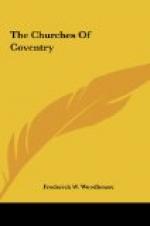The glovers’ snippings were for making size, which, with the eggs, malt and wort were used in place of water for tempering the mortar. Lightning seriously damaged the spire in 1655 and 1694, in the former case causing much injury to the nave roof by falling stone. In 1793 Wyatt, the architect responsible for so much destruction of Mediaeval work in various cathedrals, advised that a timber framework to carry the bells should be built up within the tower from the ground and that the tower arch should be bricked up. All this has been changed since 1885, the bells now hang (but are not pealed) in the octagon, the chimes and clock are in the chamber below, the arch is opened and the groining restored.
All galleries had been taken down in 1849 and the present seats, giving room for near 2,500 persons, introduced, while the incongruous wall-arcading in the apse was soon after added. At the same period many important sepulchral monuments, probably stigmatized as “excrescences,” were taken down and removed to other parts of the church.
Five years after this the exterior of the aisle walls was recased with the same friable sandstone. In 1860 the reredos was erected, the subjects of the panels being the sacrifices of Abel, Noah, Melchisedec, and Abraham, and the Last Supper. To the latest restoration, which included entire recasing of tower and spire, clearstories and chancel, the new sacristy at the south east, and other work, Mr. George Woodcock, a Coventry citizen, gave L10,500, and the sum of L39,500 was raised and expended, the re-opening taking place on 22nd April, 1890.
In 1850 a dispute of considerable public interest with regard to the levying of the church rate between the vicar and the wardens and overseers was decided in the Court of Queen’s Bench. An Act of Parliament of 1780 had empowered the wardens to levy a rate in lieu of tithe for the stipend of the vicar, to produce not less than L280 nor more than L300. The wardens having ever since allowed their powers to remain in abeyance, the vicar claimed the right to make the rate as his predecessors had done. Lord Campbell and three other judges were however unanimous in giving judgement against him.
The latest event in the history of the church is probably the most important. It has now been constituted a pro-cathedral for the proposed Diocese of Warwickshire, and a Capitular body has been formed. The statutes were promulgated by the Bishop of Worcester on the Feast of St. Michael and All Angels, 1908. The Chapter now consists of twenty-four members:—the Bishop, the Vicar of St. Michael’s (Rev. Prof. J.H.B. Masterman), the Archdeacon of Coventry, the Chancellor of the Diocese, ten priest canons and ten lay canons, with provision for the admission of a future second archdeacon. There are resemblances here to the constitution of the Southwark Chapter, consisting of four clerical and four lay canons, but




